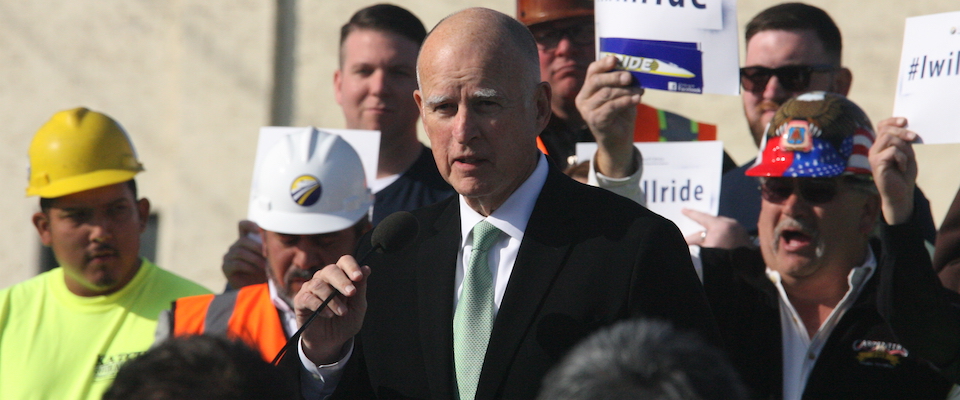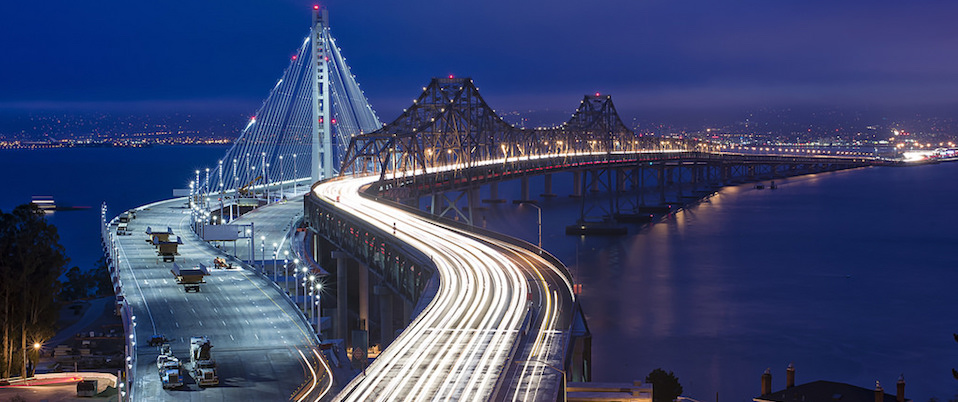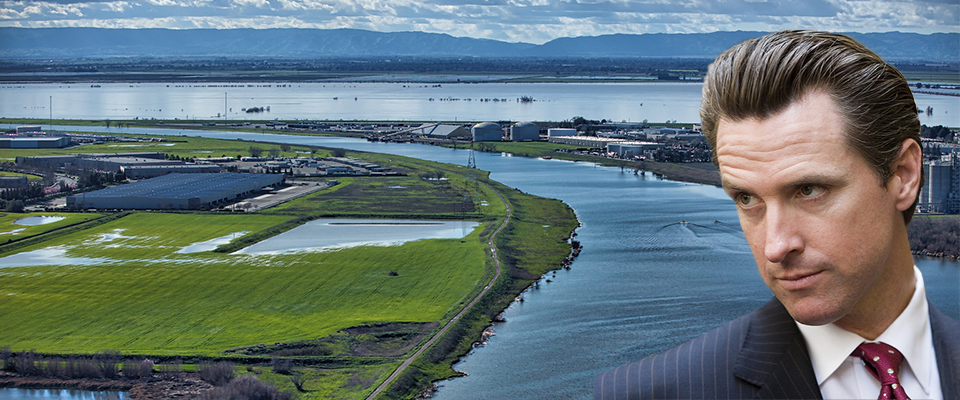The 20th century was the century of the megaproject, and as usual, California pointed the way for the nation. Southern California’s freeway system and the State Water Project, both largely completed by the 1970s, were mighty testaments to the conceit that we could build our way out of any problem. That view, of course, has since been tempered by inconvenient realities. LA traffic essentially exists in a state of permanent gridlock, and the State Water Project (SWP) and its federal counterpart, the Central Valley Project (CVP), have proven woefully inadequate in slaking the state’s thirst, as demonstrated by the recent drought.
In the past few decades, resistance to such massive engineering initiatives has grown. Decrying the expense and environmental impacts, opponents to Big Concrete advocate multiplex approaches and local solutions: public and alternative transport in all its manifestations rather than new freeways, and wastewater recycling, storm water capture, conservation—even repairing the myriad leaks that plague the state’s water systems—rather than new dams in the Sierra or more state-spanning aqueducts. Megaprojects, in short, are highly unfashionable.
Well, for the young and visionary, anyway. Older politicians, even progressive superstars like Governor Jerry Brown, still dote on them. Brown is the primary mover for the high-speed rail, the proposed super train between Los Angeles and San Francisco that faces a number of logistical roadblocks and is skyrocketing in price at an ever-accelerating rate, with the latest estimates topping $100 billion.

But the real poster child for evergreen megaproject-ism is the so-called California WaterFix, also known as the Delta Tunnels. The WaterFix essentially is a reprise of the failed Peripheral Canal, which Brown unsuccessfully pushed during his first tenure as governor in the 1980s. It would consist of two 30-mile-long subterranean tunnels that would shunt water around the Sacramento-San Joaquin Delta for delivery to large farms in the western San Joaquin Valley and the cities of Southern California.
Brown and his allies insist the project is necessary because the State Water Project currently siphons Sacramento River water from the Delta via gigantic pumps that are vulnerable to disruption from earthquakes, floods, and rising sea levels. If levees in the Delta collapse in a wholesale fashion due to any of these scenarios, saltwater from the bay would intrude to the pumps, disabling them, perhaps permanently.
But opponents maintain the WaterFix is a scam that will further degrade the already ecologically beleaguered Delta, benefit corporate farms that pollute San Joaquin Valley waterways with selenium-contaminated run-off, and do nothing to solve California’s basic water problem: there’s not enough of the wet stuff. The WaterFix expedites the delivery of water, but does nothing to expand the supply.
So is the WaterFix indeed a “fix,” or is it just another old school example of throwing money and concrete at a wicked problem and declaring victory? Maybe both.
The fact is that California is already thoroughly plumbed and piped, and that’s probably a necessity in a semi-arid state that supports almost 40 million people and a robust agricultural sector. Water conservation, recycling, and other alternative schemes are necessary, says Roger Bales—a hydrologist, the founding professor of engineering at UC Merced, and a Cal alum—but probably insufficient on their own to meet future needs. Generally speaking, says Bales, there are three essential elements to water security.
The first is infrastructure, both natural and constructed. The Delta can be considered a natural component of such infrastructure, Bales says, while dams, reservoirs, canals and pipelines are the engineered portion.
“Next is information,” Bales says. “There has to be good, transparent, and reliably transferrable information on policies and options.” In this area, Bales says, “we’ve been lacking somewhat, but things are improving.”
Finally, Bales says, there are institutions. The efficient and equitable distribution of water demands that institutions at various levels—local, regional, state, and federal—all coordinate their efforts.
“The state water plan, in fact, calls for an integrated approach to water management, and you can’t have that without all the various agencies working together,” Bales says. “They can all benefit, but that sometimes requires that they all give something up.”
Both the Delta and the Delta tunnels, says Bales, must be considered from this multi-faceted perspective. It isn’t so much a matter of saving the Delta above all else or maintaining SoCal’s water security as the prime objective, but trying to strike a balance that accommodates, if not satisfies, all stakeholders. Bales notes the state has three co-equal goals for the Delta: maintaining a mixed saltwater and freshwater habitat in the region’s waterways, sustaining local agriculture, and assuring reliable exports of water to the south.
“Scientists at Cal and UC Davis have studied these issues more than anyone, and [they conclude] that some sort of north/south cross-Delta conveyance [e.g., the Delta tunnels] that provides for freshwater releases at points along its length is the best chance to meet all three goals,” says Bales.
Indeed, a new cross-delta conveyance is necessary if the state is to avoid a catastrophe that’s all but inevitable, says Bales: the aforementioned levee failures. The Delta is comprised of “islands” that are basically holes in the ground well below sea level, the result of soil compaction and oxidation from more than a century of intensive farming. If the levees fail en masse, the Delta will be transformed from a network of farmland, canals, sloughs, and marshes to a vast, salty lake. A certain ecological stability would ultimately be reached, but one that’s far different from ecosystem that exists today. Further, cropland, homes, and commercial developments worth billions of dollars would be lost, along with the great pumps that keep the water flowing to the sprawling farms of the western San Joaquin Valley and the cities of the Southland.
“The Delta is the hub of California’s water conveyance system,” says Bales, [and] any loss of the levees that currently channel the north-south flow [of fresh water from the Sacramento River] between the Delta islands could disrupt the three goals of the state’s water plan.”
Such a levee breach cascade could be triggered by late winter or spring flooding, a big earthquake on the Hayward Fault, rising seas, burrowing animals – or all factors in unison. In any event, Bales says, UC system researchers estimate there’s a two-in-three chance of catastrophic levee failure in the Delta during the next 50 years.
“[That] is judged to be a higher probability than is acceptable for the water supply of an economy as large as California’s,” Bales says.
“A large quake in the Bay Area could take down all the levees around the Delta’s pump intakes, and that would put the whole system down. Southern California has some storage, but it wouldn’t last very long. I try not to think about it because it stresses me out.”
Jennifer Stokes-Draut, a research engineer at the Berkeley Water Center, confirms there are myriad options for obtaining water that weren’t in place when the great state and federal delivery projects were built between the 1950s to the 1970s.
“Recycling, desalinization, storm water capture, and aquifer recharge, conservation—they’re all good ways to increase supply beyond the 20th century infrastructure that we’ve depended on for more than 50 years,” says Stokes-Draut. “But that doesn’t completely answer the question of whether we need to maintain and improve the SWP and CVP, which encompasses the whole WaterFix issue. And I don’t really know the answer to that, because so much depends on political and social considerations that are outside my area of expertise, which is engineering.”
While a recent state analysis indicated net water deliveries through an upgraded system might be increased by 500,000 acre feet in an average year—enough to supply perhaps a million households—that’s not necessarily the most compelling reason for the WaterFix, allows Stokes-Draut.
“You could get that without any difficulty from conservation and other alternatives, so from that perspective an upgrade isn’t really needed,” Stokes-Draut says. “But the big thing the WaterFix would do is improve seismic safety. A large quake in the Bay Area could take down all the levees around the Delta’s pump intakes, and that would put the whole system down for a very long time. Southern California has some storage, but it wouldn’t last very long, and I really don’t know what they would do. I try not to think about it because it stresses me out.”
Another inducement to the WaterFix: most of the alternative water sources promoted by opponents are only practical on the coast. Desalinization, for example, requires proximity to the ocean. Similarly, recycling, stormwater capture, and aquifer recharge work best in urban areas that already have the requisite infrastructure in place and get relatively reliable precipitation: Big coastal cities, in other words. Alternative sources therefore aren’t much of an option for arid inland areas.
“We could probably function without the WaterFix, but it wouldn’t be as straightforward as opponents would have you believe,” says Stokes-Daut. “That said, there clearly will be environmental impacts to the Delta caused by [its construction and operation]. The Delta will be a different place than it is now. I’m less confident when it comes to predicting the ways and degrees it’ll be different. Proponents say it’ll be better, opponents say it will be worse. But there will be winners and losers no matter what’s decided, and people need to be aware of that.”
Brown has promoted one version or another of the WaterFix ever since he was reelected as Governor in 2011. The idea never really caught fire, even among the most obvious beneficiaries—South State cities and owners of large agricultural enterprises in the western San Joaquin Valley. The primary reason was that it was a massive, and massively expensive, project with no guaranteed pay-off of increased deliveries. Moreover, unlike the taxpayer financed megaprojects of the 1950s and 1960s, much of the money would have to come from the water districts identified for service. By 2017, the tunnels were floundering, and the smart money said they were metaphorical dead men walking.
But the WaterFix’s fortunes abruptly improved last month when the gigantic Metropolitan Water District of Southern California pledged $10.8 billion to the project, a sum that included the portion that was supposed to be paid by western San Joaquin Valley farmers. Along with improving its water security via the tunnels, MET hopes to recoup some of its investment by selling a portion of its contracted water to “Westside” farmers.
That doesn’t necessarily mean the WaterFix is a done deal, however. Though MET serves 26 cities and water agencies—including Los Angeles, Anaheim, and San Diego County—many of its members are pursuing separate water strategies that don’t necessarily jibe with the Delta project.
“I suspect we’re still in the initial stages of the tunnels story,” says David Sedlak, a professor of civil and environmental engineering and the co-director of the Berkeley Water Center. “What you see emerging in much of Southern California is the view that people may be better served by local solutions. The mayor of Los Angeles, for example, is committing to water reuse and storm water capture. They’re cleaning up rivers and creating parks and jobs as part of the process, and promoting their approach as self-sufficiency and a reflection of the will of the people. Orange County also has a very ambitious aquifer recharge program.”
Still, says Sedlak, there’s no real proof that such efforts will be enough to keep everyone in SoCal adequately hydrated.
“The situation with MET is fascinating, because here you have an organization with the mission of importing and selling water, and it has customers on the other end who may not want to buy that water,” Sedlak says. “I think MET may be calling LA’s bluff with its decision to fund the tunnels.”
But there’s a wild card in all of this, adds Sedlak: Desalinization.
“People are acutely aware that the state could suffer from extended droughts, and that you can only get so far with conservation and reuse, particularly if farmers are going to continue growing food and cities are allowed to expand. And we’ll probably need more than we can get by even with [enhanced] imports through the Delta. Until relatively recently, there was a lot of political headwind against desalinization. But then Carlsbad built a plant that is successfully desalinating 50 million gallons of water a day. That’s made officials more confident about building big desalinization plants, and hopeful about bringing the price of desalinated water down in the future.”
Cheaper water, maybe—but not cheap. Both desalinated water and recycled water cost upward of $2,500 an acre foot. Depending on whom you talk to, water from the Delta tunnels could run from $1,000 to $2,500 an acre foot—assuming there’s any water to deliver, which is by no means assured during drought years. Further, the costs of WaterFix water probably will run to the higher end because environmental protections for the Delta will be demanded by conservationists and likely enforced in the courts, further boosting costs. In short, if you’re a Californian, expect to pay—and pay and pay—for your water, whether you get it from a megaproject, a feel-good green alternative source, or both.
“We’ve exhausted the cheap options,” says Stokes-Draut. “Any water that’s delivered in volume will probably cost between $2,000 to $2,500 an acre foot. Conservation is cheaper, but it can’t deliver quantity. People will simply have to get used to paying more for water.”





















